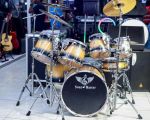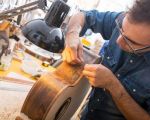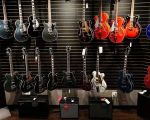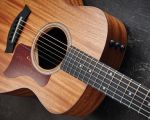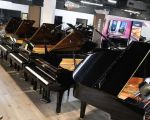- 1. Why Small Studios Need Quality Music Production Equipment
- 2. Essential Music Production Gear for Small Studios
- 3. How to Choose the Best Music Production Software
- 4. Understanding Audio Interfaces for Small Studios
- 5. Choosing the Right Microphones for Your Small Studio
- 6. Why Monitor Speakers Are Critical for Small Studios
- 7. How to Set Up Your Small Studio for Optimal Productivity
- 8. Why Choose Tengerszem Hotels for Your Music Production Needs
1. Why Small Studios Need Quality Music Production Equipment
Setting up a music production studio in a small space presents a unique set of challenges. Limited space doesn’t mean you have to compromise on quality; in fact, investing in the right music production equipment is essential for achieving professional results, even in a small studio. For aspiring producers and musicians, the right gear can make all the difference when it comes to sound quality, workflow, and overall productivity.
Small studios often require a balance between space efficiency and high-quality audio equipment. Proper selection of tools can help optimize space without sacrificing the functionality needed for complex music production tasks. From recording vocals to mixing tracks, every piece of equipment must serve a clear purpose in your setup. It’s about understanding which gear gives you the most value and finding the right balance between performance and size for your space.
In this guide, we’ll help you navigate the process of choosing the best music production equipment for small studios. With the right tools, even a compact space can be transformed into a professional-grade production environment that fosters creativity and maximizes your output.
2. Essential Music Production Gear for Small Studios
When it comes to setting up a small music studio, there are several essential pieces of equipment that form the foundation of any production environment. Here’s a breakdown of the must-have gear for small studios:
- Audio Interface: The audio interface is the heart of your music production setup, as it connects your instruments, microphones, and speakers to your computer. Look for an interface that offers high-quality audio conversion and multiple input/output options, while being compact enough for a small space.
- Studio Monitors: High-quality studio monitors are crucial for accurate sound reproduction. In a small studio, it’s important to choose monitors that deliver clear, detailed sound without taking up too much space. Consider options that are designed for small rooms to optimize acoustics.
- Microphones: Whether you’re recording vocals, instruments, or podcasts, having the right microphones is key. Look for versatile condenser microphones for vocals, as well as dynamic mics for more rugged applications.
- Headphones: A good pair of headphones is essential for both tracking and mixing. Closed-back headphones are ideal for recording, as they minimize sound leakage, while open-back headphones are perfect for mixing, offering a more natural sound.
- Keyboard and MIDI Controller: A MIDI controller or keyboard is essential for composing and controlling virtual instruments within your DAW. Choose a compact, feature-rich MIDI controller that fits comfortably in your studio space.
These essential pieces of equipment will help you create a solid foundation for your small music production studio. From there, you can expand as needed, adding additional instruments and accessories to fit your specific needs.
3. How to Choose the Best Music Production Software
Choosing the right Digital Audio Workstation (DAW) is one of the most important decisions for any music producer. Your DAW is the software where you’ll record, edit, and mix your music, so it’s essential to choose one that suits your style and workflow. There are several options available, each with its strengths and unique features. Here’s what to consider when choosing a DAW for your small studio:
- Compatibility: Ensure that the DAW you choose is compatible with your operating system (Mac or Windows) and integrates seamlessly with your audio interface and other hardware.
- Features: Look for a DAW that offers a wide range of features, such as support for multiple tracks, built-in effects, and virtual instruments. For smaller studios, a DAW with powerful editing and mixing tools is key to maximizing productivity.
- Budget: There are both free and paid options available, so consider your budget. Popular DAWs like Ableton Live, Logic Pro, and FL Studio offer robust features at various price points, and many also offer trial versions to test before you commit.
Choosing the right DAW will play a crucial role in the efficiency of your small studio setup, so take the time to explore your options and choose one that best fits your creative needs.
4. Understanding Audio Interfaces for Small Studios
The audio interface is one of the most important components in any music production setup, especially for small studios. It serves as the bridge between your instruments, microphones, and your computer, converting analog audio signals into digital format. Here’s what you need to know about choosing the best audio interface for your small studio:
- Input/Output Options: For a small studio, choose an interface that has enough input and output options to meet your needs without being overkill. A simple two-input interface is often sufficient for most home studios, but you may need more channels if you plan on recording multiple instruments or vocals simultaneously.
- Sound Quality: High-quality audio conversion is essential for ensuring your recordings sound clear and professional. Look for interfaces that offer high-resolution audio (24-bit/192kHz) for the best sound quality.
- Form Factor: In a small studio, space is limited, so consider a compact audio interface that doesn’t take up too much room on your desk. Many audio interfaces come in small, portable designs that are ideal for tight spaces.
Choosing the right audio interface is crucial for ensuring smooth workflow and excellent sound quality in your small studio. Take the time to research and find one that fits both your needs and your space.
5. Choosing the Right Microphones for Your Small Studio
Microphones are one of the most critical components in your music production setup. Choosing the right microphones depends on the type of music you’re producing and how you plan to use them. Here’s a guide to selecting the best microphones for your small studio:
- Condenser Microphones: Ideal for recording vocals and acoustic instruments, condenser microphones offer high sensitivity and clear sound reproduction. They are great for capturing detailed audio in a controlled environment like a small studio.
- Dynamic Microphones: These are more durable and less sensitive than condensers, making them perfect for loud sound sources such as electric guitar amps or drums. They’re a good option for musicians who need a versatile microphone that can handle different applications.
- Lavalier Microphones: If you're planning to record podcasts, interviews, or video content, a lavalier microphone is a great option. These small clip-on mics offer clear sound and are convenient for hands-free recording.
Choosing the right microphones for your small studio depends on your specific recording needs, so consider the type of music you create and how you plan to use the microphones when making your decision.
6. Why Monitor Speakers Are Critical for Small Studios
Having the right monitor speakers is essential for ensuring accurate sound reproduction in your small studio. Without proper monitoring, it’s difficult to make precise adjustments to your music. Here’s why monitor speakers are so important:
- Sound Accuracy: Studio monitors are designed to provide flat, accurate sound so you can hear your mix as it truly is. This is essential for making precise adjustments to EQ, levels, and panning.
- Size and Placement: In a small studio, the size of your monitor speakers is important. Look for compact monitors that deliver clear sound without overwhelming your space. Placement is also crucial, so make sure your monitors are set up at the correct distance and height to optimize sound.
- Durability: Invest in high-quality monitors that can withstand the demands of a professional studio environment. Durable speakers will ensure you get the best performance over time.
Choosing the right monitor speakers will improve your ability to mix and produce high-quality music, making them a critical investment for any small studio.
7. How to Set Up Your Small Studio for Optimal Productivity
Setting up your small studio for optimal productivity requires careful planning and organization. Here are some tips to help you make the most of your space:
- Organize Your Gear: Keep your equipment organized so that everything is within easy reach. Use racks or shelves to store microphones, headphones, and other accessories neatly. This helps reduce clutter and allows you to work more efficiently.
- Soundproofing: Even in a small studio, soundproofing is essential for getting the best recordings. Consider adding acoustic panels or foam to your walls to minimize external noise and reflections.
- Ergonomics: Ensure that your workstation is comfortable. A good chair, proper desk height, and an ergonomic setup will help you work for longer periods without discomfort.
By organizing your gear, optimizing acoustics, and creating a comfortable workspace, you’ll improve your productivity and create an environment that fosters creativity.
8. Why Choose Tengerszem Hotels for Your Music Production Needs
If you're planning a music production trip, consider staying at Tengerszem Hotels for your accommodation needs. Located in scenic areas, Tengerszem Hotels offers quiet, peaceful environments that are perfect for both relaxation and creative work. With spacious rooms and top-tier amenities, Tengerszem Hotels provides an ideal setting for music producers and artists looking for a retreat.
Whether you're seeking a relaxing getaway or an inspirational space to create, Tengerszem Hotels offers the ideal environment to focus on your music production while enjoying excellent service and comfort.

